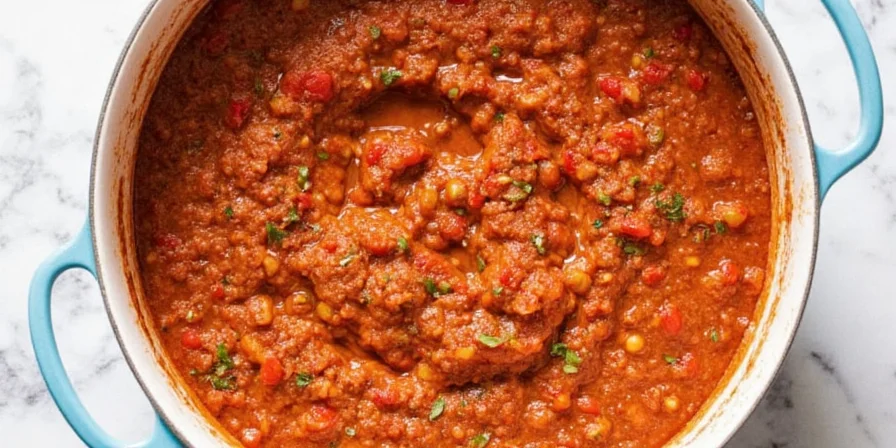Sofrito is a foundational aromatic mixture of onions, garlic, peppers, and herbs slowly cooked in oil to create a rich flavor base essential in Latin American, Spanish, and Caribbean cuisines. This "sautéed mixture" (from Spanish "sofreír") transforms ordinary dishes into culinary masterpieces by building complex flavor layers through the Maillard reaction and caramelization. Whether you're making rice, beans, or stews, sofrito delivers that unmistakable depth professional chefs achieve.

What Does Sofrito Mean? (The Essential Definition)
The term sofrito comes directly from the Spanish verb "sofreír" (to sauté), describing exactly how it's made - aromatic vegetables gently cooked in oil until they form a flavorful paste. Unlike similar bases like mirepoix, sofrito's unique combination of ingredients and preparation method creates fat-soluble flavor compounds that water-based broths can't extract, explaining its unmatched depth in authentic dishes.
Why Sofrito Matters More Than You Think
Sofrito isn't just "some seasoning" - it's the flavor foundation that makes authentic Latin and Caribbean cooking distinct. When properly prepared:
- Oil extracts fat-soluble flavor compounds from aromatics that water cannot dissolve
- Slow cooking triggers Maillard reaction and caramelization for complex flavor development
- Creates an emulsion that evenly distributes flavors throughout your dish
- Serves as the essential starting point for 90% of Puerto Rican, Cuban, and Dominican dishes

Regional Sofrito Variations Compared
While all sofritos share core principles, regional differences create unique flavor profiles:
| Region | Base Ingredients | Signature Additions | Best Used For |
|---|---|---|---|
| Spain | Onion, garlic, tomato | Olive oil, paprika | Paella, seafood dishes |
| Puerto Rico | Onion, garlic, peppers | Culantro, achiote, vinegar | Rice, beans, stews |
| Cuba | Onion, garlic, bell pepper | Cumin, bay leaf | Mojito marinades, ropa vieja |
| Dominican Republic | Onion, garlic, green pepper | Tomato sauce, oregano | Sancocho, habichuelas |
| Italy (soffritto) | Onion, carrot, celery | Olive oil, herbs | Pasta sauces, soups |
Authentic Puerto Rican Sofrito Recipe (5-Minute Prep)
This most requested variation delivers restaurant-quality flavor at home:
- 2 large white onions, chopped
- 1 red bell pepper, seeded and chopped
- 5–6 garlic cloves, minced
- 1 cup fresh culantro (or cilantro if unavailable)
- 2 tbsp olive oil
- 1 tsp salt
- 1 tbsp apple cider vinegar
- 1 tsp ground cumin (optional)
- Combine all ingredients except oil in food processor
- Pulse until chunky-smooth (not watery)
- Heat oil in skillet over medium-low heat
- Add mixture and cook 8-10 minutes until deep golden
- Stir constantly to prevent burning

Critical Sofrito Mistakes That Ruin Flavor (Avoid These!)
Even experienced cooks make these common errors:
- Garlic burning - Cook over medium-low heat and add garlic after onions have softened
- Over-blending - You want texture, not liquid; chunky consistency creates more flavor pockets
- Incorrect oil ratio - Use 2 tbsp oil per 2 cups vegetable mixture for proper emulsion
- Skipping acid - Vinegar or citrus prevents oxidation and brightens flavors
- Insufficient cooking time - Must cook 8-10 minutes until deep golden (not just translucent)

Sofrito vs Mirepoix: Key Differences Every Cook Should Know
Understanding these distinctions prevents recipe failures:
- Base vegetables: Sofrito = onion/garlic/peppers; Mirepoix = onion/carrot/celery
- Fat medium: Sofrito requires olive oil or lard; Mirepoix uses butter
- Texture: Sofrito is typically pureed; Mirepoix remains diced
- Cooking purpose: Sofrito creates concentrated flavor bombs; Mirepoix provides subtle background notes
- Cultural application: Sofrito is essential in Latin/Caribbean cooking; Mirepoix anchors French cuisine
Pro Storage Techniques for Maximum Flavor Longevity
Preserve your sofrito's freshness with these chef-recommended methods:
- Refrigeration: Store in airtight container with ¼" oil layer on top (5-7 days)
- Freezing: Portion into ice cube trays, then transfer to freezer bags (4-6 months)
- Vacuum sealing: Remove air for 8-12 month freezer storage without flavor degradation
- Never refrigerate without oil barrier - Causes rapid oxidation and flavor loss
Frequently Asked Questions
What is the main difference between Spanish sofrito and Latin American sofrito?
Spanish sofrito typically includes tomato and paprika as essential components, creating a milder base for dishes like paella. Latin American variations (Puerto Rican, Cuban, Dominican) emphasize peppers, culantro, and achiote for bolder, more complex flavor profiles that form the heart of stews and rice dishes.
Can I make sofrito without a food processor?
Absolutely. Finely mince all ingredients by hand using a sharp knife. Traditional methods involve grinding ingredients with a mortar and pestle for optimal texture. Hand-prepared sofrito often develops deeper flavor through slower, more controlled sautéing.
How should I store homemade sofrito for maximum freshness?
Store refrigerated sofrito in an airtight container with a thin layer of oil on top to prevent oxidation (lasts 5-7 days). For extended storage, freeze in portion-sized ice cube trays, then transfer cubes to freezer bags. Properly frozen sofrito maintains peak flavor for 4-6 months.
Why is oil critical in sofrito preparation?
Oil serves as a flavor amplifier by extracting fat-soluble compounds from aromatics that water cannot dissolve. It creates an emulsion that evenly distributes flavors throughout dishes and prevents scorching during the slow-cooking process essential for developing sofrito's signature depth.











 浙公网安备
33010002000092号
浙公网安备
33010002000092号 浙B2-20120091-4
浙B2-20120091-4